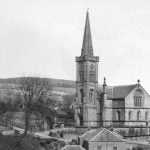Whilst British politicians claimed they were defending their right to partially control the South African Republic, many historians stress that in reality the Boer War was all about the control of the rich Witwatersrand gold-mining complex located in the Republic. It was the largest gold-mining complex in the world at a time when the world’s monetary systems, pre-eminently the British, were increasingly dependent upon gold.
Some 22,000 British and Imperial troops died in the campaign against the Boers, 16,000 from sickness and 6,000 from enemy action. With their deaths so far away and no individual graves in Britain around which to mourn, remember and celebrate, those left behind required other forms of commemoration and so war memorials were constructed.
Over £200 was collected for this memorial in Alyth and Messrs Bower & Florence, one of the most important firms of granite sculptors in Aberdeen, were commissioned to erect the handsome obelisk on the corner at the west side of the Market Square. It was unveiled with some ceremony by the Marquis of Breadalbane in August 1901.
The inscription reads as follows:
TO THE MEMORY OF THREE BRAVE MEN
David Stanley William, ninth Earl of Airlie, Lieutenant-Colonel 12th Royal Lancers, killed in action (as he always desired to die) at Diamond Hill, South Africa, 11th June 1900.
Extract from Lord Roberts despatch, 12th June, 1900 - “I deplore the death of that gallant soldier, the Earl of Airlie”.
Nigel Neis Ramsay, younger of Bamff, Lieutenant 2nd Battalion Royal Highlanders, killed in action at Magersfontein, 11th December 1899.
Charles James Wedderburn Ogilvy, younger of Ruthven, Trooper of the Fife and Forfar Light Horse, 20th Company I.Y., who died at sea, 6th March 1900.
Local sources have discovered that a David Smith Johnston, Provost of Alyth in the late 1800’s, paid off the remaining debt for the memorial and paid for its upkeep until his death in 1919.
Civic war memorials were not only a site of collective tribute but also a key symbol of community worth and Alyth was no exception. The civic leaders of the town at this time were anxious that their commemorative project for the fallen in this war should not be subsumed by larger regional schemes already underway, and the death of the Earl of Airlie at the battle of Diamond Hill on 11th June 1900, triggered them to act. Eager to claim the Earl as one of their own (he was also Baron Ogilvy of Alyth and Lintrathen) and concerned that a competing plan had already been launched in neighbouring Kirriemuir, where Airlie was also a major landholder, a hastily convened meeting took place in Alyth Town Hall. It overruled the suggestion that ”no memorial should be gone on with until after the war… as the fighting might claim more victims” and resolved to press ahead with the construction of a commemorative obelisk in the Market Square immediately.
With the unveiling taking place in August 1901, a full ten months before the signing of the Peace of Vereeniging, the editor of the Alyth Guardian newspaper felt it necessary to explain to his readers, in terms redolent of civic pride, why the town required its own memorial. It was, he wrote, because “Alyth had suffered in so special a manner from the South African war that, instead of joining with neighbouring communities in commemorating the fallen it was fitting it should have a local monument to commemorate its own gallant dead”.
Fortunately for the civic authorities, the Earl of Airlie and the two other men commemorated on the monument were the total war deaths suffered by the town.
Sources:
Remembering the South African War by Peter McIntosh Donaldson, the Scottish Military Research Group, Alyth Family History Project



